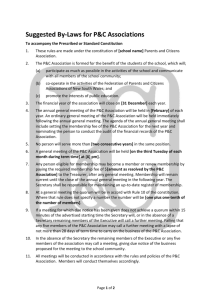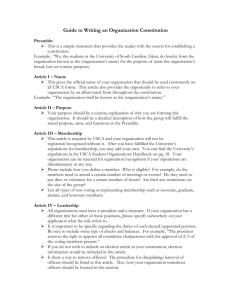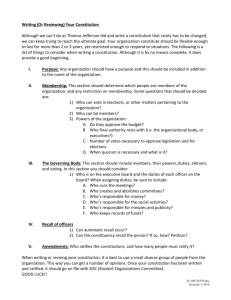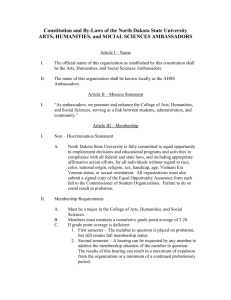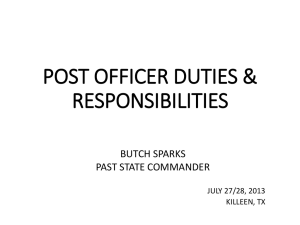Constitution and By-Laws Guidelines for Student
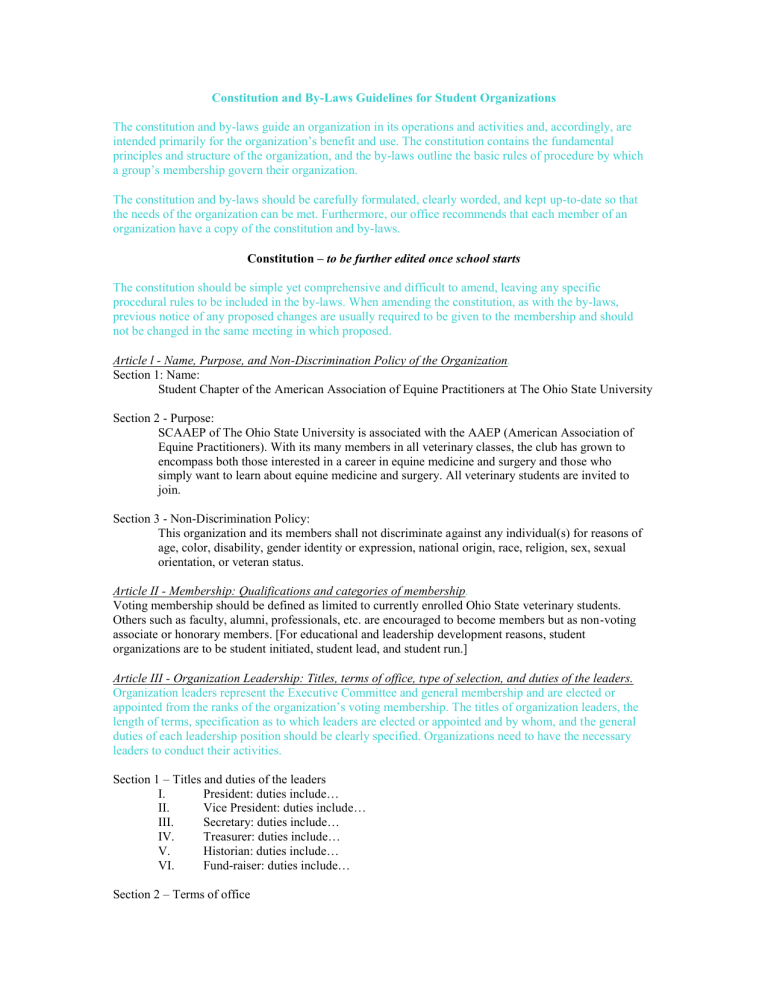
Constitution and By-Laws Guidelines for Student Organizations
The constitution and by-laws guide an organization in its operations and activities and, accordingly, are intended primarily for the organization’s benefit and use. The constitution contains the fundamental principles and structure of the organization, and the by-laws outline the basic rules of procedure by which a group’s membership govern their organization.
The constitution and by-laws should be carefully formulated, clearly worded, and kept up-to-date so that the needs of the organization can be met. Furthermore, our office recommends that each member of an organization have a copy of the constitution and by-laws.
Constitution – to be further edited once school starts
The constitution should be simple yet comprehensive and difficult to amend, leaving any specific procedural rules to be included in the by-laws. When amending the constitution, as with the by-laws, previous notice of any proposed changes are usually required to be given to the membership and should not be changed in the same meeting in which proposed.
Article l - Name, Purpose, and Non-Discrimination Policy of the Organization .
Section 1: Name:
Student Chapter of the American Association of Equine Practitioners at The Ohio State University
Section 2 - Purpose:
SCAAEP of The Ohio State University is associated with the AAEP (American Association of
Equine Practitioners). With its many members in all veterinary classes, the club has grown to encompass both those interested in a career in equine medicine and surgery and those who simply want to learn about equine medicine and surgery. All veterinary students are invited to join.
Section 3 - Non-Discrimination Policy:
This organization and its members shall not discriminate against any individual(s) for reasons of age, color, disability, gender identity or expression, national origin, race, religion, sex, sexual orientation, or veteran status.
Article II - Membership: Qualifications and categories of membership .
Voting membership should be defined as limited to currently enrolled Ohio State veterinary students.
Others such as faculty, alumni, professionals, etc. are encouraged to become members but as non-voting associate or honorary members. [For educational and leadership development reasons, student organizations are to be student initiated, student lead, and student run.]
Article III - Organization Leadership: Titles, terms of office, type of selection, and duties of the leaders.
Organization leaders represent the Executive Committee and general membership and are elected or appointed from the ranks of the organization’s voting membership. The titles of organization leaders, the length of terms, specification as to which leaders are elected or appointed and by whom, and the general duties of each leadership position should be clearly specified. Organizations need to have the necessary leaders to conduct their activities.
Section 1 – Titles and duties of the leaders
I.
President: duties include…
II.
III.
IV.
V.
VI.
Vice President: duties include…
Secretary: duties include…
Treasurer: duties include…
Historian: duties include…
Fund-raiser: duties include…
Section 2 – Terms of office
The length of term for all positions is one year from beginning of term.
Section 3 – Type of selection
Officers will be selected by a majority vote from currently enrolled veterinary students with paid membership in the club.
Section 4 – SOURCE training
The advisor, president, and treasurer must attend one SOURCE orientation per academic year to maintain the club’s organizational status.
Article IV - Executive Committee: Size and composition of the Committee .
The executive committee represents the general membership and conducts business of the organization between general meetings of the membership and reports its actions at the general meetings of the membership. This committee is comprised of the organization leaders and chairpersons of any standing committees.
Article V - Standing Committees (if needed): Names, purposes, and composition.
These committees serve the organization leadership, Executive Committee, and general membership and are permanent and designed to carry out the basic functions of the organization. Chairpersons of these committees are appointed by the organization leadership.
Article VI – Adviser(s) or Advisory Board: Qualification Criteria .
Advisers of student organizations must be full-time members of the University faculty or
Administrative & Professional staff. Responsibilities, and expectations of advisers should be clearly and adequately described.
Article VII – Meetings of the Organization: Required meetings and their frequency .
Section 1 – Required meetings
At least three general meetings and two executive committee meetings are required per academic quarter, except for summer.
Section 2 – Frequency of meetings
Ideally, there will be at least one general meeting per month, but frequency of meetings may be adjusted according to academic schedules and availability of speakers.
Article VIII – Method of Amending Constitution: Proposals, notice, and voting requirements .
Proposed amendments should be in writing, should not be acted upon but read in the general meeting in which they are proposed, should be read again at a specified number of subsequent general meetings and the general meeting in which the votes will be taken, and should either require a two-third or three-quarter majority of voting members (a quorum being present) or a majority or two-thirds of the entire voting membership of the organization, present or not. The constitution should not be amended easily or frequently.
Article IX – Method of Dissolution of Organization
Requirements and procedures for dissolution of the student organization should be stated. Should any organization assets and debt exist, appropriate means fort disposing of these assets and debts should be specified clearly and unequivocally.
By-Laws
By-laws contain the standing (permanent) rules of procedure of an organization. Items in the by-laws may be covered in appropriate detail in the constitution of very small organizations. However, most groups keep the two separate because by-laws usually contain more detail and are subject to change more than that of the constitution and, therefore, may require different procedures for amending.
Provision for amendment of the by-laws should be somewhat easier than that of the constitution as rules of procedure should adapt to changing conditions of the student organization. When amending the by-laws, as with the constitution, previous notice of any changes are usually required to be given to the membership and should not be changed in the same meeting in which proposed.
By-laws are more permanent, however, than passing a general motion, which may require only a simple majority vote of voters present at a general meeting of the membership (a quorum being present). By-laws cannot run contrary to the constitution.
Article 1 – Parliamentary Authority
Most organizations use Robert’s Rule of Order to govern their organization’s decision making except when these rules are inconsistent with their constitution or by-laws of the organization. These rules are of
Western cultural origin, and based on the premise that “though the minority shall be heard and absentees protected, the majority will decide.”
A recommended wording is “The rules contained in [specify the source for parliamentary practice] shall govern the organization in all cases to which they are applicable, and in which they are not inconsistent with the by-laws of this organization.”
Article II- Membership
Section 1 – Procedure for becoming a member
Any currently enrolled veterinary student may contact the secretary with their desire to become a member. Dues must be fully paid to gain and maintain membership.
Section 2 – Dues
Dues must be paid annually to maintain membership. The amount of dues is to be maintained as
$XX.XX per year.
Section 3 – Termination of membership
Any club member may terminate their membership at any time by contacting the appropriate officer. However, dues may not be refunded for that academic year.
Section 4 – Maintenance of member list
The club member list must be updated at least once per quarter and is to be maintained by the secretary. This list must include the member’s name, class rank, email address, meeting attendance, and dues status.
Article III- Election / Appointment of Government Leadership
Section 1 – Eligibility for office
Any currently paid member of the club is eligible to run for any leadership position.
Section 2 – Nomination process
Nominations may be made by any paid member until the commencement of elections.
Section 3 – Election timing
Elections will be held during the winter quarter of the academic year.
Section 4 – Election procedures
Section 5 – Design of ballots and balloting procedures
Section 6 – Appointment and ratification procedures
Section 7 – Special circumstances
I.
II.
III.
Resignations or ineligibilities
Impeachments
Special elections
Article IV- Executive Committee (if needed)
Specific duties of the Committee and its responsibilities to the membership include scheduling at least the previously determined amount of general meetings per quarter, arranging appropriate speakers, arranging fund-raising opportunities for the organization, and responsibly managing the organizations finances.
Article V- Standing Committees (if needed)
Specific duties of each committee and their responsibilities to the organization leadership, Executive
Committee, and general membership.
Article VI - Adviser/Advisory Board Responsibilities
The advisor is expected to attend all general and executive committee meetings when his/her schedule allows. He/She is expected to assist in providing contacts for possible speakers, when needed.
Article VII - Meeting Requirements
Section 1 – General meeting
General meetings will be held at least three times per quarter and preferably at least once per month. If finances and the situation allows, food and drinks will be provided for all attending paid members. An RSVP may be required to determine number of members attending.
Section 2 – Special meetings
Special meetings are defined as seminars or short courses and may last one to several days in length. The number of members allowed to attend may be limited, and which members are permitted to attend will be determined according to veterinary class, number of years in club, attendance at prior meetings or events, expectation to assist with event, and/or lottery. If a wet lab is part of a seminar or short course, members must attend all previous lectures to participate.
Section 3 – Quorum
Quorum is defined as the number of voting members required to vote on decisions placed before the general membership, executive, and standing committees, and is set at one-half plus one of the total member number.
Article VIII - Method of Amending By-Laws
Should be similar to amending the constitution. However, by-laws are apt to change more often than the constitution, thus amending should be somewhat easier. By-laws may be amended by proposing in writing and reading the change at a general meeting of the membership and then bring the proposed change up for a vote at the next general meeting with a 2/3 majority vote of the membership present (a quorum being present).
Article IX – Availability of Constitution and By-Laws to Members
The constitution and by-laws must be made available to all members. A current version of both should be made available on the club’s website, and a hard copy should be provided upon request.
Constitution Rev. 8/17/2006

